随机过程作业和答案第三章
- 格式:doc
- 大小:439.00 KB
- 文档页数:9
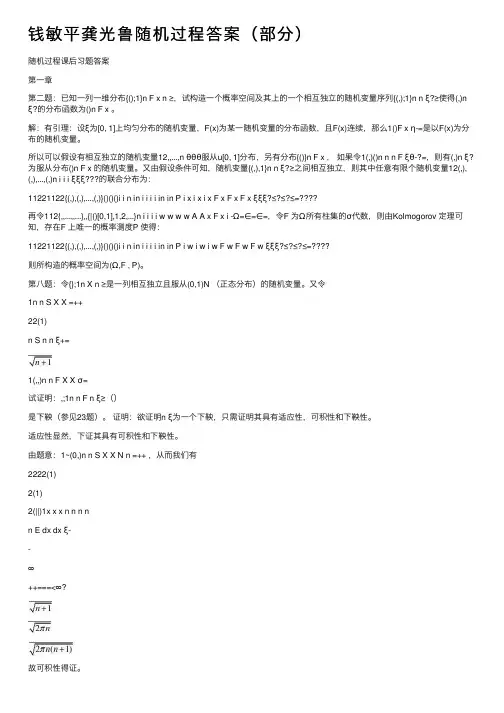
钱敏平龚光鲁随机过程答案(部分)随机过程课后习题答案第⼀章第⼆题:已知⼀列⼀维分布{();1}n F x n ≥,试构造⼀个概率空间及其上的⼀个相互独⽴的随机变量序列{(,);1}n n ξ?≥使得(,)n ξ?的分布函数为()n F x 。
解:有引理:设ξ为[0, 1]上均匀分布的随机变量,F(x)为某⼀随机变量的分布函数,且F(x)连续,那么1()F x η-=是以F(x)为分布的随机变量。
所以可以假设有相互独⽴的随机变量12,,...,n θθθ服从u[0, 1]分布,另有分布{()}n F x ,如果令1(,)()n n n F ξθ-?=,则有(,)n ξ?为服从分布()n F x 的随机变量。
⼜由假设条件可知,随机变量{(,),1}n n ξ?≥之间相互独⽴,则其中任意有限个随机变量12(,), (,),...,(,)n i i i ξξξ的联合分布为:11221122{(,),(,),...,(,)}()()()i i n in i i i i in in P i x i x i x F x F x F x ξξξ?≤?≤?≤=再令112{,,...,,...},,{|()[0,1],1,2,...}n i i i i w w w w A A x F x i -Ω=∈=∈=,令F 为Ω所有柱集的σ代数,则由Kolmogorov 定理可知,存在F 上唯⼀的概率测度P 使得:11221122{(,),(,),...,(,)}()()()i i n in i i i i in in P i w i w i w F w F w F w ξξξ?≤?≤?≤=则所构造的概率空间为(Ω,F , P)。
第⼋题:令{};1n X n ≥是⼀列相互独⽴且服从(0,1)N (正态分布)的随机变量。
⼜令1n n S X X =++22(1)n S n n ξ+=1(,,)n n F X X σ=试证明:,;1n n F n ξ≥()是下鞅(参见23题)。

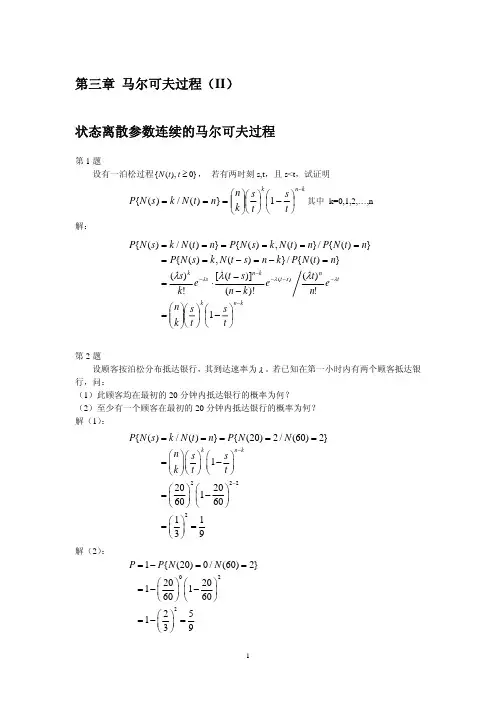
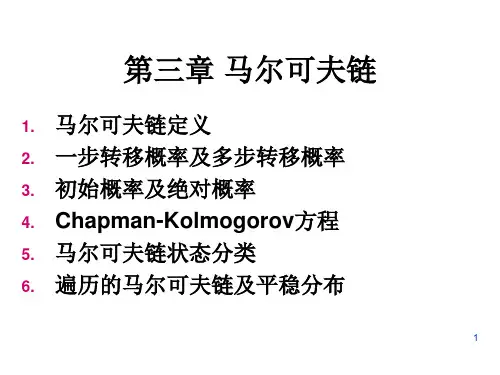
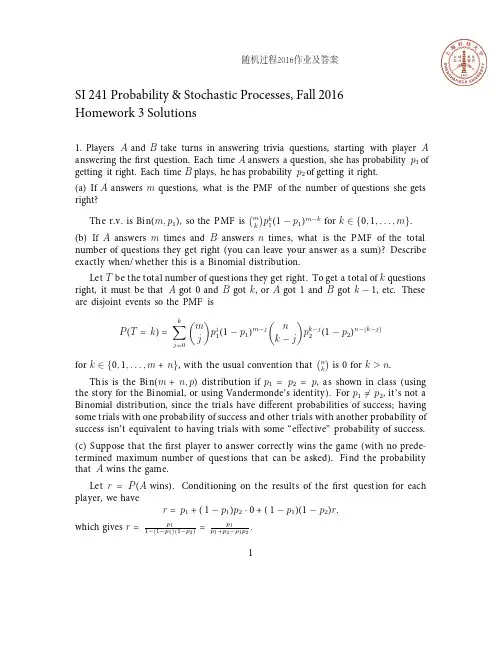
1.Players A and B take turns in answering trivia questions, starting with player A answering the first question. Each time A answers a question, she has probability p 1 of getting it right. Each time B plays, he has probability p 2 of getting it right.(a)If A answers m questions, what is the PMF of the number of questions she gets right?The r.v.is Bin(m,p 1),so the PMF is mkp k 1(1 p 1)m k for k 2{0,1,...,m }.(b)If A answers m times and B answers n times,what is the PMF of the total number of questions they get right (you can leave your answer as a sum)?Describe exactly when/whether this is a Binomial distribution.Let T be the total number of questions they get right.To get a total of k questions right,it must be that A got 0and B got k ,or A got 1and B got k 1,etc.These are disjoint events so the PMF isP (T =k )=k X j =0✓mj ◆p j 1(1 p 1)m j ✓n k j◆p k j 2(1 p 2)n (k j )for k 2{0,1,...,m +n },with the usual convention that n k is 0for k >n .This is the Bin(m +n,p )distribution if p 1=p 2=p ,as shown in class (using the story for the Binomial,or using Vandermonde’s identity).For p 1=p 2,it’s not a Binomial distribution,since the trials have di ↵erent probabilities of success;having some trials with one probability of success and other trials with another probability of success isn’t equivalent to having trials with some “e ↵ective”probability of success.(c)Suppose that the first player to answer correctly wins the game (with no prede-termined maximum number of questions that can be asked).Find the probability that A wins the game.Let r =P (A wins).Conditioning on the results of the first question for each player,we have r =p 1+(1 p 1)p 2·0+(1 p 1)(1 p 2)r,which gives r =p 11 (1 p 1)(1 p 2)=p 1p 1+p 2 p 1p 2.1SI 241 Probability & Stochastic Processes, Fall 2016Homework 3 Solutions随机过程2016作业及答案2.A message is sent over a noisy channel.The message is a sequence x1,x2,...,x n of n bits(x i2{0,1}).Since the channel is noisy,there is a chance tha t any bit might be corrupted,resulting in an error(a0becomes a1or vice versa).Assume that the error events are independent.Let p be the probability that an individual bit has an error(0<p<1/2).Let y1,y2,...,y n be the received message(so y i=x i if there is no error in that bit,but y i=1 x i if there is an error there).To help detect errors,the n th bit is reserved for a parit y check:x n is defined to be 0if x1+x2+···+x n 1is even,and1if x1+x2+···+x n 1is odd.When the message is received,the recipient checks whether y n has the same parit y as y1+y2+···+y n 1. If the parity is wrong,the recipient knows that at least one error occurred;otherwise, the recipient assumes that there were no errors.(a)For n=5,p=0.1,what is the probabilit y that the received message has errors which go undetected?Note that P n i=1x i is even.If the number of errors is even(and nonzero),the errors will go undetected;otherwise,P n i=1y i will be odd,so the errors will be detected.The number of errors is Bin(n,p),so the probability of undetected errors when n=5,p=0.1is✓52◆p2(1 p)3+✓54◆p4(1 p)⇡0.073.(b)For general n and p,write down an expression(as a sum)for the probability that the received message has errors which go undetected.By the same reasoning as in(a),the probability of undetected errors isX k even,k 2✓n k◆p k(1 p)n k.(c)Give a simplified expression,not involving a sum of a large number of terms,for the probabilit y that the received message has errors which go undetected.Hint for(c):Lettinga=X k even,k 0✓n k◆p k(1 p)n k and b=X k odd,k 1✓n k◆p k(1 p)n k,the binomial theorem makes it possible tofind simple expressions for a+b and a b, which then makes it possible to obtain a and b.2Let a,b be as in the hint.Thena +b =X k 0✓n k ◆p k (1 p )n k =1,a b =X k 0✓n k ◆( p )k (1 p )n k =(1 2p )n .Solving for a and b gives a =1+(1 2p )n 2and b =1 (1 2p )n2.Xk even,k 0✓n k ◆p k (1 p )n k =1+(1 2p )n 2.Subtrac ting o ↵the possibility of no errors,we haveX k even,k 2✓n k ◆p k (1 p )n k =1+(1 2p )n 2 (1 p )n .Miracle check :note that letting n =5,p =0.1here gives 0.073,which agrees with (a);letting p =0gives 0,as it should;and letting p =1gives 0for n odd and 1for n even,which agai n makes sense.33.Let X be a r.v. whose possible values are 0, 1, 2,...,with CDF F .In some countries, rather than using a CDF, the convention is to use the function G defined by G (x )=P (X <x ) to specify a distribution. Find a way to convert from F to G , i.e., if F is a known function show how to obtain G (x )for all real x .Write G (x )=P (X x ) P (X = x )=F (x ) P (X = x ).If x is not a nonnegative integer, then P (X = x )=0so G (x )=F (x ). For x a nonnegative integer,P (X = x )=F (x ) F (x 1/2)since the PMF corresponds to the lengths of the jumps in the CDF. (The 1/2was chosen for concreteness; we also have F (x 1/2) = F (x a )for any a 2 (0, 1].)Thus,G (x )=(F (x )if x /2{0,1,2,...}F (x 1/2)if x 2{0,1,2,...}.t More compact ly, we can also write G (x )=lim !x F (t ), where the denotes taking a limit from the left (recall that F is right continuous), and G (x )=F (d x e 1),where d x e is the “ceiling” of x (the smallest integer greater than or equal to x ).4.There are n eggs, each of which hatches a chick with probability p (independently).Eac h of these chicks survives with probability r , independently. What is the distri-bution of the number of chicks that hatch? What is the distribution of the number of chicks that survive? (Give the PMFs; also give the names of the distributions and their parame ters, if they are distributions we have seen in class.)⇤⇥ ©⇤⇥ x ⇤⇥ ⇤⇥ ⇤⇥ ©⇤⇥ ©⇤⇥ x ⇤⇥ ©⇤⇥ ⇤⇥©Let H be the number of eggs that hatch and X be the number of hatchlings that survive.Think of each egg as a Ber noulli trial,where for H we define “success”to mean hatching,while for X we define “success”to mean surviving.For example,in the picture above,where ⇤⇥ ©denotes an egg that hatches with the chick surviving,⇤⇥ x denotes an egg that hatched but whose chick died,and ⇤⇥ denotes an egg that hatch,the events H =7,X =5occurred.By the of the Binomial,H ⇠Bin(n,p ),with PMF P (H =k )= n k p k (1 p )n k for k =0,1,...,n .The eggs independently have probability pr each of hatching a chick that survives.By the story of the Binomial,we have X ⇠Bin(n,pr ),with PMF P (X =k )= n k (pr )k (1 pr )n k for k =0,1,...,n .5.A scientist wishes to study whether men or women are more likely to have a certain disease, or whether they are equally likely. A random sample of m women and n men is gathered, and each person is tested for the disease (assume for this problem that the test is completely accurate). The numbers of women and men in he sa B n(n,w p ho ha He ve re p h e di and seas p e ar are e X unkno and Y wn,re p s and ec w tiv e e r a ly,Y i 2.1 2 e w in ith tereste d ⇠Bi in n(testin g p 1) a the le mp t t X ,m nd ⇠) “null hypothesis” p 1 = p 2.(a) Consider a 2 by 2 ta ble listing with rows corresponding to disease status and columns corresponding to gender, with each entry the count of how many people have that disease status and gender (so m + n is the sum of all 4 entries). Supp ose that it is observed that X + Y = r .The Fisher exact test is based on conditioning on both the row and column sums, so m, n, r are all treated as fixed, and then seeing if the observed value of X is “extreme” compared to this conditional distribution. Assuming the null hypothesis, use Ba yes’ Rule to find the conditional PMF of X given X + Y = r .Is this a distribution we have studied in class? If so, say which (and give its paramet ers).First let us build the 2 ⇥ 2 table (conditioning on the totals m, n, and r ).4Women Men Total Disease x r No Diseasem x r r x +n x m +n r Total n m m +nNext,let us compute P (X =x |X +Y =r ).By Ba yes’rule,P (X =x |X +Y =r )=P (X +Y =r |X =x )P (X =x )P (X +Y =r )=P (Y =r x )P (X =x )P (X +Y =r ).Y Assum Bi i n n (g n,th p e )w nu i l t l h h X ypot inde h p esi e s nde an n d t l of etti Y ng ,s p o =X p +1Y =p 2Bi ,w n(e n h +ave m,X p ).⇠T Bi h n us (,m,p )and ⇠⇠r x p r x p p )r n (1 r +x n m x p x (1 p )m x (1m + n r p )m +n r P (X =x |X +Y =r )== m nx m +r n rx .So the conditional distribution is Hypergeometric with parameters m, n, r.(b) Give an intuitive explanation for the distribution of (a), explaining how this problem relates to other problems we’ve seen, and why p 1 disappears (magica lly?) in the distribution found in (a).This problem has the same structure as the elk (capture-recapture) problem. In the elk problem, we take a sample of elk from a population, where earlier some were tagged, and we want to know the distribution of the number of tagged elk in the sample. By analogy, think of the women as corresponding to tagged elk, and men as corresponding to unta gged elk. Having r people be infected with the disease corresponds to capturing a new sample of r elk the number of women among the r diseased individuals corresponds to the number of tagged elk in the new sample.Under the null hypothesis and given that X + Y = r ,the set of diseased people is equally likely to be any set of r people.It makes sense that the conditional distribution of the number of diseased women does not depend on p ,since once we know tha t X + Y = r ,we can work directly in terms of the fact that we have a population with r diseased and m + n r undiseased people, without worrying about the value of p that originally generated the population characteristics.5。
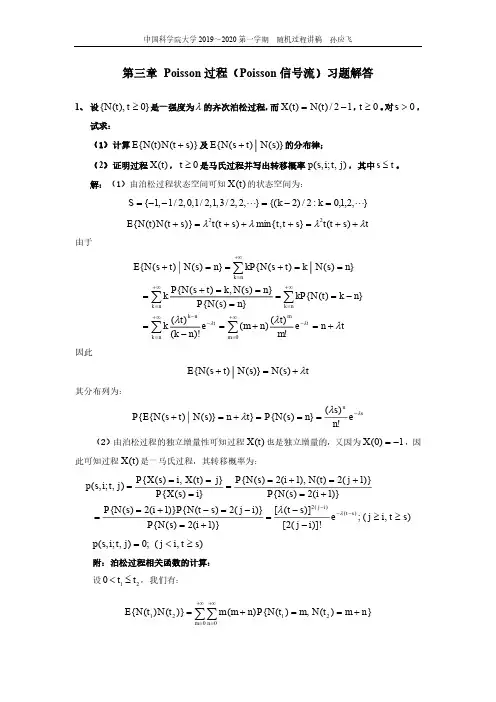
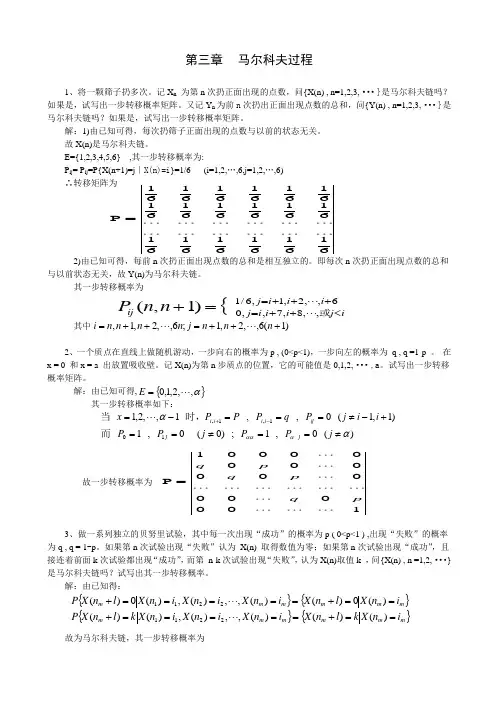
第三章 马尔科夫过程1、将一颗筛子扔多次。
记X n 为第n 次扔正面出现的点数,问{X(n) , n=1,2,3,···}是马尔科夫链吗?如果是,试写出一步转移概率矩阵。
又记Y n 为前n 次扔出正面出现点数的总和,问{Y(n) , n=1,2,3,···}是马尔科夫链吗?如果是,试写出一步转移概率矩阵。
解:1)由已知可得,每次扔筛子正面出现的点数与以前的状态无关。
故X(n)是马尔科夫链。
E={1,2,3,4,5,6} ,其一步转移概率为:P ij = P ij =P{X(n+1)=j ∣X(n)=i }=1/6 (i=1,2,…,6,j=1,2,…,6) ∴转移矩阵为2)由已知可得,每前n 次扔正面出现点数的总和是相互独立的。
即每次n 次扔正面出现点数的总和与以前状态无关,故Y(n)为马尔科夫链。
其一步转移概率为其中2、一个质点在直线上做随机游动,一步向右的概率为p , (0<p<1),一步向左的概率为 q , q =1-p 。
在x = 0 和x = a 出放置吸收壁。
记X(n)为第n 步质点的位置,它的可能值是0,1,2,···,a 。
试写出一步转移概率矩阵。
解:由已知可得, 其一步转移概率如下:故一步转移概率为3、做一系列独立的贝努里试验,其中每一次出现“成功”的概率为p ( 0<p<1 ) ,出现“失败”的概率为q , q = 1-p 。
如果第n 次试验出现“失败”认为 X(n) 取得数值为零;如果第n 次试验出现“成功”,且接连着前面k 次试验都出现“成功”,而第 n-k 次试验出现“失败”,认为X(n)取值k ,问{X(n) , n =1,2,···}是马尔科夫链吗?试写出其一步转移概率。
解:由已知得:故为马尔科夫链,其一步转移概率为616161616161616161616161616161616161P ={6,,2,1,6/1,,8,7,,0)1,(+++=<++==+i i i j i j i i i j ij n n P 或)1(6,,2,1;6,,2,1,+++=++=n n n j n n n n i {}α,,2,1,0 =E )(0,1;)0(0,1)1,1(0,,1,,2,1101,1,ααααα≠==≠==+-≠===-=-+j P P j P P i i j P q P P P x j j ij i i i i 而时,当 10000000000000001Pp q p q p q ={}{}m m m m m m i n X l n X i n X i n X i n X l n X P ==+=====+)(0)()(,,)(,)(0)(2211 {}{}mm m m m m in X k l n X i n X i n X i n X k l n X P ==+=====+)()()(,,)(,)()(22114、在一个罐子中放入50个红球和50个蓝球。
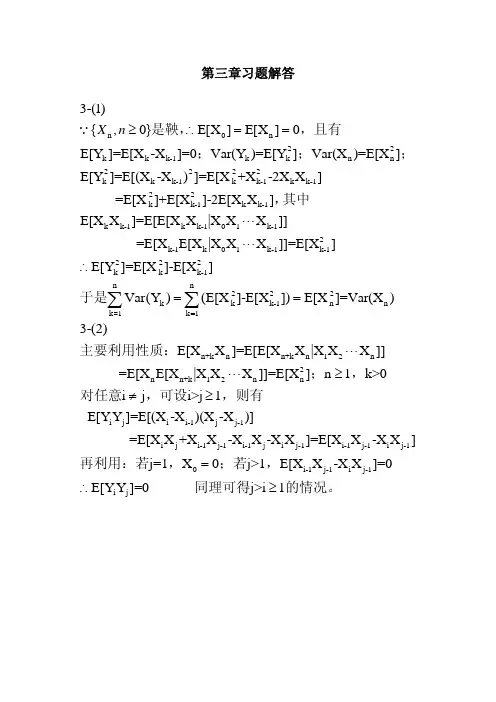
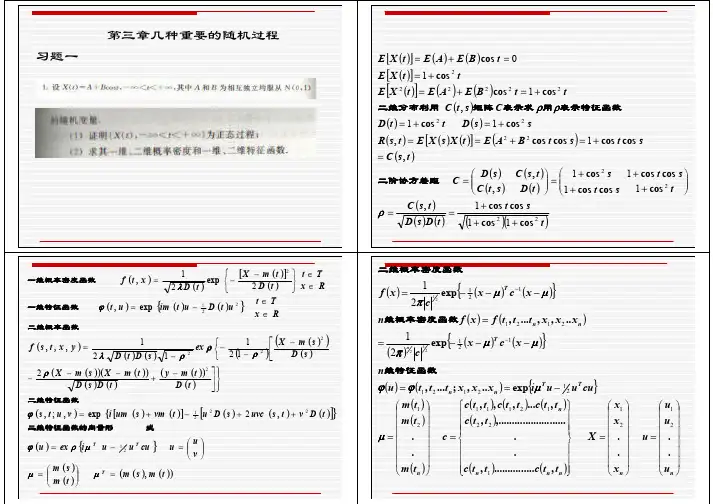
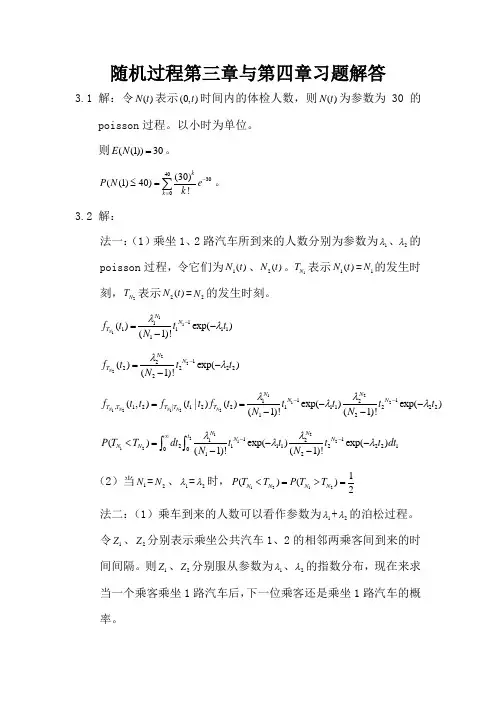
随机过程第三章与第四章习题解答3.1 解:令()N t 表示(0,)t 时间内的体检人数,则()N t 为参数为30的poisson 过程。
以小时为单位。
则((1))30E N =。
4030(30)((1)40)!k k P N e k -=≤=∑。
3.2 解:法一:(1)乘坐1、2路汽车所到来的人数分别为参数为1λ、2λ的poisson 过程,令它们为1()N t 、2()N t 。
1N T 表示1()N t =1N 的发生时刻,2N T 表示2()N t =2N 的发生时刻。
1111111111()exp()(1)!N NN T f t t t N λλ-=-- 2221222222()exp()(1)!N NN T f t t t N λλ-=--1212121221112,12|12211122212(,)(|)()exp()exp()(1)!(1)!N N N N N NNN N T T T T T f t t f t t f t t t t t N N λλλλ--==---- 12212121112211122210012()exp()exp()(1)!(1)!NNt N N N N P T T dt t t t t dt N N λλλλ∞--<=----⎰⎰(2)当1N =2N 、1λ=2λ时,12121()()2N N N N P T T P T T <=>=法二:(1)乘车到来的人数可以看作参数为1λ+2λ的泊松过程。
令1Z 、2Z 分别表示乘坐公共汽车1、2的相邻两乘客间到来的时间间隔。
则1Z 、2Z 分别服从参数为1λ、2λ的指数分布,现在来求当一个乘客乘坐1路汽车后,下一位乘客还是乘坐1路汽车的概率。
212211122210()exp()exp()z p P Z Z dz z z dz λλλλ∞=<=--⎰⎰112λλλ=+。
故当一个乘客乘坐1路汽车后,下一位乘客乘坐2路汽车的概率为1-p 212λλλ=+上面的概率可以理解为:在乘客到来的人数为强度1λ+2λ的泊松过程时,乘客分别以112λλλ+概率乘坐公共汽车1,以212λλλ+的概率乘坐公共汽车2。
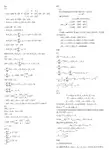
本章练习题:3-1.设是的高斯随机变量,试确定随机变量的概率密度函数,其中均为常数。
查看参考答案3-2.设一个随机过程可表示成式中,是一个离散随机变量,且试求及。
查看参考答案3-3.设随机过程,若与是彼此独立且均值为0、方差为的高斯随机变量,试求:(1)、(2)的一维分布密度函数;(3)和。
查看参考答案3-4.已知和是统计独立的平稳随机过程,且它们的均值分别为和,自相关函数分别为和。
(1)试求乘积的自相关函数。
(2)试求之和的自相关函数。
查看参考答案3-5.已知随机过程,其中,是广义平稳过程,且其自相关函数为=随机变量在(0,2)上服从均匀分布,它与彼此统计独立。
(1)证明是广义平稳的;(2)试画出自相关函数的波形;(3)试求功率谱密度及功率。
查看参考答案3-6.已知噪声的自相关函数为=(为常数)(1)试求其功率谱密度及功率;(2)试画出及的图形。
查看参考答案3-7.一个均值为,自相关函数为的平稳随机过程通过一个线性系统后的输出过程为(为延迟时间)(1)试画出该线性系统的框图;(2)试求的自相关函数和功率谱密度。
查看参考答案3-8. 一个中心频率为、带宽为的理想带通滤波器如图3-4所示。
假设输入是均值为零、功率谱密度为的高斯白噪声,试求:图3-4(1)滤波器输出噪声的自相关函数;(2)滤波器输出噪声的平均功率;(3)输出噪声的一维概率密度函数。
查看参考答案3-9. 一个RC低通滤波器如图3-5所示,假设输入是均值为零、功率谱密度为的高斯白噪声,试求:(1)输出噪声的功率谱密度和自相关函数;(2)输出噪声的一维概率密度函数。
图3-5查看参考答案3-10. 一个LR低通滤波器如图3-6所示,假设输入是均值为零、功率谱密度为的高斯白噪声,试求:(1)输出噪声的自相关函数;(2)输出噪声的方差。
图3-6查看参考答案3-11.设有一个随机二进制矩形脉冲波形,它的每个脉冲的持续时间为,脉冲幅度取的概率相等。
3-1、设X 是0,1a σ==的高斯随机变量,试确定随机变量Y cX d =+的概率密度函数()f y ,其中,c d 均为常数。
解:由题得:2()0,()1E x a D x σ====()()()E y E cx d cE x d c a d d=+=+=+=222()()D y D cx d c c σ=+==22()()]2x d f y c -=-3-2、设随机过程()t ξ可表示成()2cos(2)t t ξπθ=+,式中θ是一个离散随机变量,且11(0),()222P P πθθ====,试求(1)E ε和(0,1)R ε解:首先应理解(1)E ε和(0,1)R ε的含义,(1)E ε是指当t=1时,所得随机变量的均值,(0,1)R ε 是指当t=0和t=1时,所得的两个随机变量的自相关函数。
111[2cos(2)][2cos(2)]2(cos0cos )1222t E E E εππθπθ==+=+=+=22211(0,1)[(0)(1)][2cos 2cos(2)]4[cos ]4(cos 0cos )2222R E E E επξξθπθθ==⨯+==+=3-3、设1020()cos sin z t x t x t ωω=-是一随机过程,若1x 和2x 是彼此独立且具有均值为0,方差为2σ的正态随机变量,试求: (1)2[()],[()]E z t E z t(2)z(t)的一维分布密度函数f(z); (3)12(,)B t t 和12(,)R t t解:(1)由已知条件12[][]0E X E X ==且1x 和2x 彼此相互独立。
所以1212[][][]0E X X E X E X == 212()()D x D x σ==,而222[][]E x E x σ=- 所以222111[]()[]E x D x E x σ=+=同理 222[]E x σ=10200102[()][cos sin ]cos []sin []0E z t E x t x t tE x tE x ωωωω=-=-=2210202222102012002201020012222200[()][(cos sin )][cos sin 2cos sin ]cos 2[]sin []2cos sin [](cos sin )E z t E x t x t E x t x t x x t t tE x tE x t tE x x t t ωωωωωωωωωωωωσσ=-=+-=+-=+=(2)由于1x 和2x 是彼此独立的正态随机变量且()z t 是1x 和2x 的线性组合,所以z 也是均值为0,方差为2σ的正态随机变量,其一维概率密度为22())2z f z σ=-(3)1,2121012011022022010*********()[()()]{[cos sin ][cos sin ]}[cos cos sin sin ][cos ()]R t t E z t z t E x t x t x t x t t t t t t t ωωωωσωωωωσω==--=+=-令12t t γ-=,则21,20()cos R t t σωγ==2121212120(,)(,)[()][()](,)cos B t t R t t E z t E z t R t t σωγ=-==3-4、已知()x t 与()y t 是统计独立的平稳随机过程,且它们的均值分别为12(),a a τ,自相关函数分别为(),()x y R R ττ。
第一章习题解答1. 设随机变量X 服从几何分布,即:(),0,1,2,k P X k pq k ===L 。
求X 的特征函数,EX 及DX 。
其中01,1p q p <<=-是已知参数。
解 0()()jtxjtkk X k f t E eepq ∞===∑Q()k jtkk p q e∞==∑ =0()1jt kjtk pp qe qe ∞==-∑又200()kkk k q qE X kpq p kq p p p ∞∞======∑∑Q222()()[()]q D X E X E X P =-=(其中 00(1)nnn n n n nxn x x ∞∞∞====+-∑∑∑)令 0()(1)n n S x n x ∞==+∑则 1000()(1)1xxnn k n xS t dt n t dt x x∞∞+===+==-∑∑⎰⎰202201()()(1)11(1)1(1)xn n dS x S t dt dxx xnx x x x ∞=∴==-∴=-=---⎰∑同理 2(1)2kkkk k k k k k x k x kx x ∞∞∞∞=====+--∑∑∑∑令20()(1)k k S x k x ∞==+∑ 则211()(1)(1)xkk k k k k S t dt k t dt k xkx ∞∞∞+====+=+=∑∑∑⎰)W2、(1) 求参数为(,)p b 的Γ分布的特征函数,其概率密度函数为1,0()0,0()0,0p p bxb x e x p x b p p x --⎧>⎪=>>Γ⎨⎪≤⎩(2) 其期望和方差;(3) 证明对具有相同的参数的b 的Γ分布,关于参数p 具有可加性。
解 (1)设X 服从(,)p b Γ分布,则10()()p jtxp bxX b f t ex e dx p ∞--=Γ⎰ 1()0()p p jt b x b x e dx p ∞--=Γ⎰101()()()()(1)p u p p p p p b e u b u jt b x du jt p b jt b jt b∞----==Γ---⎰ 1(())x p p e x dx ∞--Γ=⎰Q (2)'1()(0)X p E X f j b∴== 2''221(1)()(0)X p p E X f j b +== 222()()()PD XE X E X b∴===(4) 若(,)i i X p b Γ: 1,2i = 则121212()()()()(1)P P X X X X jt f t f t f t b-++==-1212(,)Y X X P P b ∴=+Γ+:同理可得:()()iiP X b f t b jt∑=∑- W3、设X 是一随机变量,()F x 是其分布函数,且是严格单调的,求以下随机变量的特征函数。
第三章 马尔科夫过程1、将一颗筛子扔多次。
记X n 为第n 次扔正面出现的点数,问{X(n) , n=1,2,3,···}是马尔科夫链吗?如果是,试写出一步转移概率矩阵。
又记Y n 为前n 次扔出正面出现点数的总和,问{Y(n) , n=1,2,3,···}是马尔科夫链吗?如果是,试写出一步转移概率矩阵。
解:1)由已知可得,每次扔筛子正面出现的点数与以前的状态无关。
故X(n)是马尔科夫链。
E={1,2,3,4,5,6} ,其一步转移概率为:P ij = P ij =P{X(n+1)=j ∣X(n)=i }=1/6 (i=1,2,…,6,j=1,2,…,6) ∴转移矩阵为2)由已知可得,每前n 次扔正面出现点数的总和是相互独立的。
即每次n 次扔正面出现点数的总和与以前状态无关,故Y(n)为马尔科夫链。
其一步转移概率为其中2、一个质点在直线上做随机游动,一步向右的概率为p , (0<p<1),一步向左的概率为 q , q =1-p 。
在x = 0 和x = a 出放置吸收壁。
记X(n)为第n 步质点的位置,它的可能值是0,1,2,···,a 。
试写出一步转移概率矩阵。
解:由已知可得, 其一步转移概率如下:故一步转移概率为3、做一系列独立的贝努里试验,其中每一次出现“成功”的概率为p ( 0<p<1 ) ,出现“失败”的概率为q , q = 1-p 。
如果第n 次试验出现“失败”认为 X(n) 取得数值为零;如果第n 次试验出现“成功”,且接连着前面k 次试验都出现“成功”,而第 n-k 次试验出现“失败”,认为X(n)取值k ,问{X(n) , n =1,2,···}是马尔科夫链吗?试写出其一步转移概率。
解:由已知得:故为马尔科夫链,其一步转移概率为616161616161616161616161616161616161P ={6,,2,1,6/1,,8,7,,0)1,(+++=<++==+i i i j i j i i i j ij n n P 或)1(6,,2,1;6,,2,1,+++=++=n n n j n n n n i {}α,,2,1,0 =E )(0,1;)0(0,1)1,1(0,,1,,2,1101,1,ααααα≠==≠==+-≠===-=-+j P P j P P i i j P q P P P x j j ij i i i i 而时,当 10000000000000001Pp q p q p q ={}{}m m m m m m i n X l n X i n X i n X i n X l n X P ==+=====+)(0)()(,,)(,)(0)(2211 {}{}mm m m m m in X k l n X i n X i n X i n X k l n X P ==+=====+)()()(,,)(,)()(22114、在一个罐子中放入50个红球和50个蓝球。
每随机地取出一球后,再放入一个新球进去,新球为红球和兰球的概率各为1/2。
第n 次取出一球后,又放入一个新球,留下的红球数记为X(n)。
问{X(n) , n =1,2,···}是马尔科夫链吗?试写出一步转移概率矩阵(当 n ≥50)。
解:由已知得,将来状态X(n)只与当前状态X(n-k)有关,故X(n)为马尔科夫链5、随机地扔两枚分币,每枚分币的面有“国徽”和“分值”之分。
X(n) 表示两枚分币分扔 n 次后面正面出现“国徽”的总个数。
试问X(n)是否是马尔科夫链?写出一步转移概率。
解:由已知得,将来状态X(n)只与当前状态X(n-k)有关。
故X(n)是马尔科夫链。
6、扔一颗筛子,如果前n 次扔出现点数的最大值为j ,就说X(n)的值等于。
试问{X(n) , n =1,2,···}是不是马尔科夫链?并写出一步转移概率矩阵。
解:由已知得,将来状态X(n)只与当前状态X(n-k)有关。
故X(n)是马尔科夫链。
⎪⎩⎪⎨⎧+===+,取其他值01,0,)1,(P j j p j q n n ij)1(6,,2,1;6,,2,1,+++=++=n n n j n n n n i 其中{}21210020012110099010099212001000100992110010020099212001002121)99(0)1(0211001i )2200i -10021100i -100P 200i 21100i P )()(2121100i 10021100i P 9932i 150,100,,2,1,0100,1100,100100,992,11,1,,ij一步转移概率矩阵为时,球)蓝个红球又放回蓝个红(取出时,,,)时,一步转移概率当<=>=======•==•==•-+•==≥=+-i P j P P P P P i i n E i j j i i j i i ⎪⎪⎪⎩⎪⎪⎪⎨⎧+=+==+取其他值其一步转移概率为j i j i i j n n ,01,212,,41)1,(P ij )1(2,,1,0;2,,1,0+==n j n i 其中其一步转移概率矩阵为7、假定随机变量X 0的概率分布为 P{X 0=1}=p , P{X 0= -1}=1-p ,0<p<1,对n = 0,1,2,3,…, 定义 1)画出{X(n) , n = 0,1,2,3,…}的所有样本函数。
2)说明{X(n) , n = 0,1,2,3,…}不具有马尔科夫性(既无后效性。
解:1)2)当n 取值时,X(2n+1)的值先于当n-1时的X(2n)的值∴{X(n) , n = 0,1,2,…}不具有马尔科夫性,即不具有无后效性。
8、将适当的数字填入下面空白处,使矩阵是一步转移概率矩阵。
解:()为偶数当为奇数当n n 00{2X X n X -=()012=+n X )6,,2,1,()(0,)(61,6 =<=>==j i i j P i j P i P j i j i i i 10000061650000616164000616161630061616161620616161616161P =其一步转移概率矩阵为43411101101101313131=P 00434110001011011071013131310=P9、设马尔科夫链的一步转移概率矩阵为试求二步转移概率解:10、设马尔科夫链的一步转移概率为,其中p>0,q<0,p+q=1。
试求二步转移概率矩阵和三步转移概率矩阵,并用数学归纳法证明一般n 步转移概率矩阵为解:1)⎥⎦⎤⎢⎣⎡++==2222222)2(q p pqpq q p P P ⎥⎦⎤⎢⎣⎡++++==2332322333333)3(pq p q q p q q p pq p P P2)证明:a)当n=1时,等式成立b)假设当n=k 时,等式成立 即:则当n=k+1时,即当n=k+1时,等式成立。
综合a),b)得,一般n 步转移概率矩阵位11、设马尔科夫链具有状态空间E={1,2,3},初始概率分布为612131313131613121=P ⎥⎥⎥⎥⎥⎥⎦⎤⎢⎢⎢⎢⎢⎢⎣⎡=⎥⎥⎥⎥⎥⎥⎦⎤⎢⎢⎢⎢⎢⎢⎣⎡==4136131879218718792125125612131313131613121612131313131613121)2(2P P p q q p P =n n nn q p q p q p q p P )(1)(1)(1)(121-+-----+=p q q p P =)1(⎥⎦⎤⎢⎣⎡-+-----+=⎥⎦⎤⎢⎣⎡-++--+--+-++=⎥⎦⎤⎢⎣⎡-+-----+=⋅=+++++++++11111111)(1)(1)(1)(121)()()()(21)(1)(1)(1)(121)()1(k k k k k k k k nn nn q p q p q p q p q p q p q p q p q p q p q p q p p q q p q p q p q p q p P k P k Pk k kk q p q p q p q p k P )(1)(1)(1)(121)(-+-----+=n n nn q p q p q p q p P )(1)(1)(1)(121-+-----+=412141)0(3)0(2)0(1===P P P和一步转移概率矩阵为(1) 计算P{X(0)=1,X(1)=2,X(2)=2};(2) 试证P{X(1)=2,X(2)=2 | X(0)=1}=p 12p 22 (3) 计算p 12(2)。
解:1)2)3)12、设马尔科夫链具有状态空间E={1,2 },初始概率分布为和一步转移概率矩阵为(1) 计算P{X(0)=1,X(1)=2,X(2)=2};(2) 计算P{X(n)=1,X(n+1)=2,X(n+2)=2},n=1,2,3; (3) 计算P{X(n)=1, X(n+2)=2},n=1,2,3; (4) 计算P{ X(n+2)=2},n=1,2,3; (5) 在(1),(2),(3),(4)中哪些依赖于n ,哪些不依赖于n 。
解:1)⎥⎥⎥⎥⎥⎥⎦⎤⎢⎢⎢⎢⎢⎢⎣⎡=4341031313104341P ()()(){}161314304131430213143141)1()1()0()1()1()0()1()1()0()1()1()0(22,21,10221231)0(3221221)0(231221211)0(13122121)0(=⨯⨯⨯+⨯⨯⨯+⨯⨯⨯=++=====∑∑==p p p p p p p p p p p p p p p p X X X P i i i i ()()(){}()()(){}{}2212221211)0(1221211)0(1)1()1()0()1()1()0(1)0(22,21,1010|22,21p p p p p p p p p p X P X X X P X X X P ===========16741031434341)1()1()1()1()1()1()1()1()2(323122211211312112=⨯+⨯+⨯=++==∑=P P P P P P P P P r r r 100)0(2)0(1=+>>==b a b a b P a P ⎥⎥⎥⎦⎤⎢⎢⎢⎣⎡=21213132P ()()(){}62131021311)1()1()0()1()1()0()1()1()0(22,21,10221221)0(231221211)0(12122121)0(ab a p p p p p p p p p p p p X X X P i i i i =⨯⨯⨯+⨯⨯⨯=+=====∑∑==2)()()(){}()()(){}()()(){}()()()(){}()()(){}()(){}[]()(){}[]⎪⎭⎫⎝⎛+=+======⎪⎭⎫⎝⎛+=⎪⎭⎫ ⎝⎛⨯+⨯=+=======⨯+⨯=+===∴⎥⎥⎥⎦⎤⎢⎢⎢⎣⎡=⎥⎥⎥⎦⎤⎢⎢⎢⎣⎡===+=+=⎪⎭⎫ ⎝⎛⨯+⨯⨯=+======⎥⎥⎥⎦⎤⎢⎢⎢⎣⎡==+=⎪⎭⎫ ⎝⎛⨯+⨯⨯=+======⎥⎥⎥⎦⎤⎢⎢⎢⎣⎡==+=⨯⨯⨯+⨯⨯⨯=+=========+=+=∑∑∑∑∑∑∑∑========36127187)2()2()2()2()2(24,12,26211872132187)1()1()2()2()1(23,11,118721313132)1()1()1()1()1()1()2(187)2(1251271871811)2(31213132)1()1()0(22,1)3)2167243(6172432161302131)3()3()1()1()1()1()3(25,24,1372297243216862161303)36127(6112718112131)2()2()1()1()1()1()2(24,23,1212512718718112)621(61213121213132)1()0()1()1()0()1()1()0(23,22,11,1)1()1()0(22,21,1210211011221121)0(210211011221121)0(22121211221112122121121)0(21)0(211)0(121122121121)0(321)0(211)0(121122121121)0(2211221)0(2211211)0(12121121)0(2121121)0(a p p p p p p p p X X P n a b a p p p p p p p p X X P n P P P P P P P P P P p p p p n X n X P ab a p p p p p p p p p p X X X P P n ab a p p p p p p p p p p X X X P P n ab a p p p p p p p p p p p p X X X P n p p p p n X n X n X P i i i i i i r r r i i i i i i i i i i i i i i i 原式当原式当原式时,当原式时,当原式当13、在12题中,初始概率分布为试对n=1,2,3计算其绝对概率分布 解:14、设马尔科夫链的一步转移概率矩阵为其中p<0,q>0,r>0,且p+q+r=1,初始概率分布为 试对n=1,2,3计算其绝对概率分布()(){}(){}(){}(){}(){}。